Fixing System Clocks (SSDT-AWAC/RTC0)
What this SSDT does
The purpose of SSDT-AWAC/RTC0 is to fix the system clocks found on newer hardware, mainly found in the following:
- B360
- B365
- H310
- H370
- Z370 (Gigabyte and AsRock boards with newer BIOS versions)
- Z390
- B460
- Z490
- 400 series (Comet Lake, including Z490)
- 495 series (Icelake)
- X99
- X299
SSDT-AWAC tries to re-enable the old RTC clock that is compatible with macOS, while SSDT-RTC0 will instead create a "fake" RTC clock if there is no legacy one to enable.
Methods to make this SSDT
For the RTC fix, there are 3 methods you can choose from:
- Prebuilt
- SSDTTime
- Does not support HEDT
- Manual
- For most users
- Manual HEDT
- For X99 and X299 users
Prebuilt
By far the easiest method, all you need to do is download the following file:
- SSDT-AWAC.aml
- For most users
- SSDT-RTC0-RANGE-HEDT
- For Intel's X99 and X299 platforms
Main things to note with this method:
- Assumes you both have an AWAC clock and it can be easily turned off with the RTC replacing it, this may not always work
- This only applies to SSDT-AWAC
- SSDT-RTC0-RANGE instead relies on known RTC names, and can only handle so many edge cases
- Doesn't really teach you anything
- For most, this doesn't matter. But to some knowing what makes your hackintosh tick is part of the journey
SSDTTime
Nota
Non supporta HEDT (X99 e X299)
The second involves using SSDTTime which automates most of the process. See here on how to use it: SSDTs: Easy Way
To get the SSDT-PMC, run the following:
7. Dump DSDTthen run6. AWAC
This will provide you with some files, the main one you care about is SSDT-AWAC.aml. or SSDT-RTC0.aml. The DSDT and .dsl are only left for referencing or verification.
The main things to note with this method:
- Doesn't really teach you anything
- For most, this doesn't matter. But to some knowing what makes your hackintosh tick is part of the journey
Manual
Determining which SSDT you need
Nota
X99 e X299 vedere qui
Finding which SSDT you need is quite easy actually, first open your decompiled DSDT you got from Dumping the DSDT and Decompiling and Compiling with either MaciASL(if in macOS) or any other text editor if in Windows or Linux(VSCode has an ACPI extension that can also help).
Next search for ACPI000E. You should get something similar:
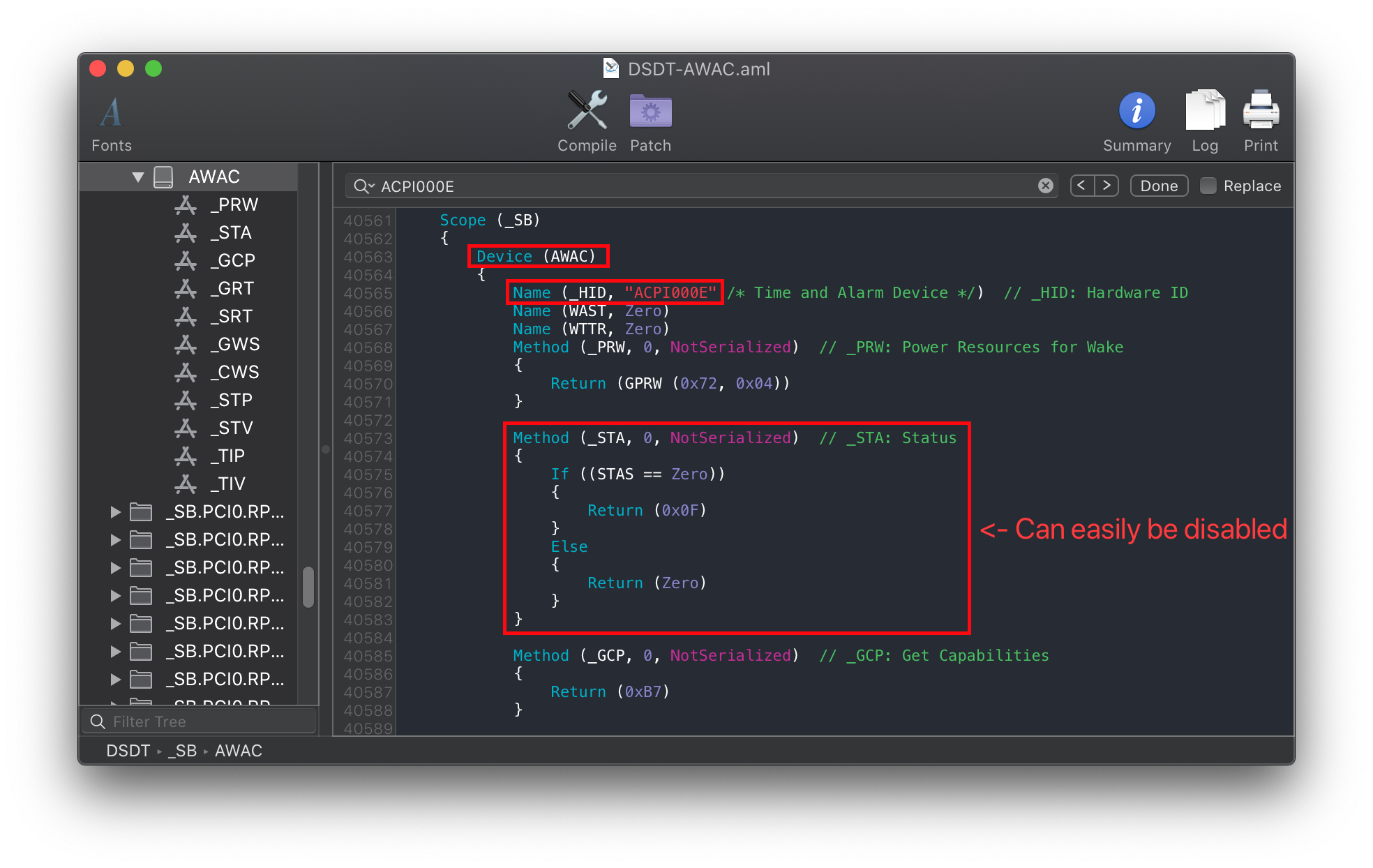
The above tells us a few things:
- We in fact do have an AWAC clock
- If nothing shows up, you don't need to do anything for AWAC or RTC
- It can be easily disabled with STAS(if not, you can skip to here: RTC0 Method)
_STAis the device status, withZeromeaning it won't show up
But to double check, next search for PNP0B00:
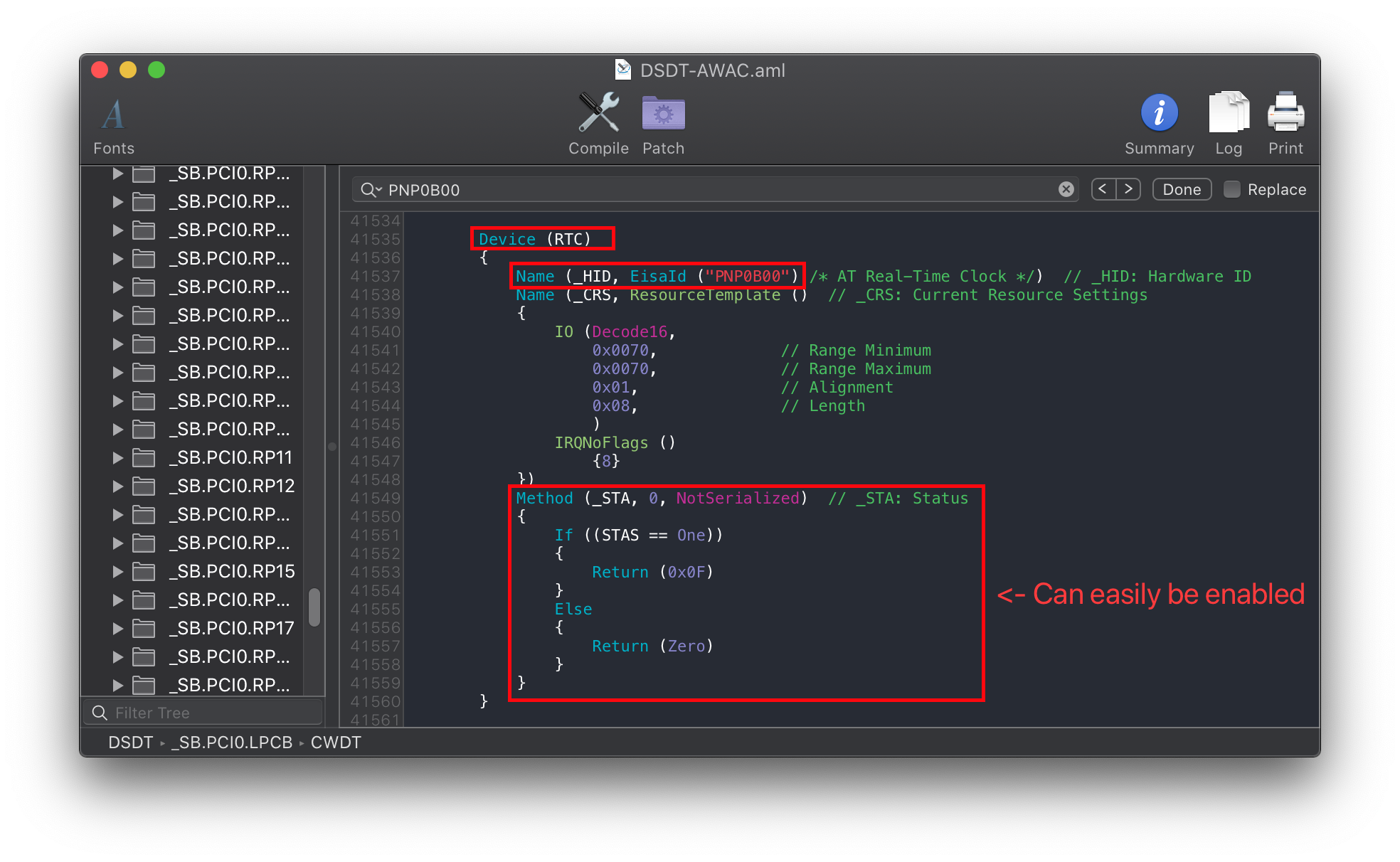
And looks at that, we can in fact disable our AWAC and enable the RTC! If not skip to here: RTC0 Method
Now it's as simple as grabbing SSDT-AWAC.dsl and compile, no changes needed You can also use the below SSDT to the same effect:
RTC0 Method
This method is for those who either don't have a PNP0B00 device to re-enable or have no easy way(via STAS variable).
Finding the ACPI path
Assuming you've gotten your DSDT already opened from earlier, search for the following:
- Finding the LowPinCount path:
- Search
Name (_ADR, 0x001F0000)
- Search
- Finding the PCI path:
- Search
PNP0A08(If multiple show up, use the first one)
- Search
You should get something like the following show up:
| LPC Pathing | PCI Pathing |
|---|---|
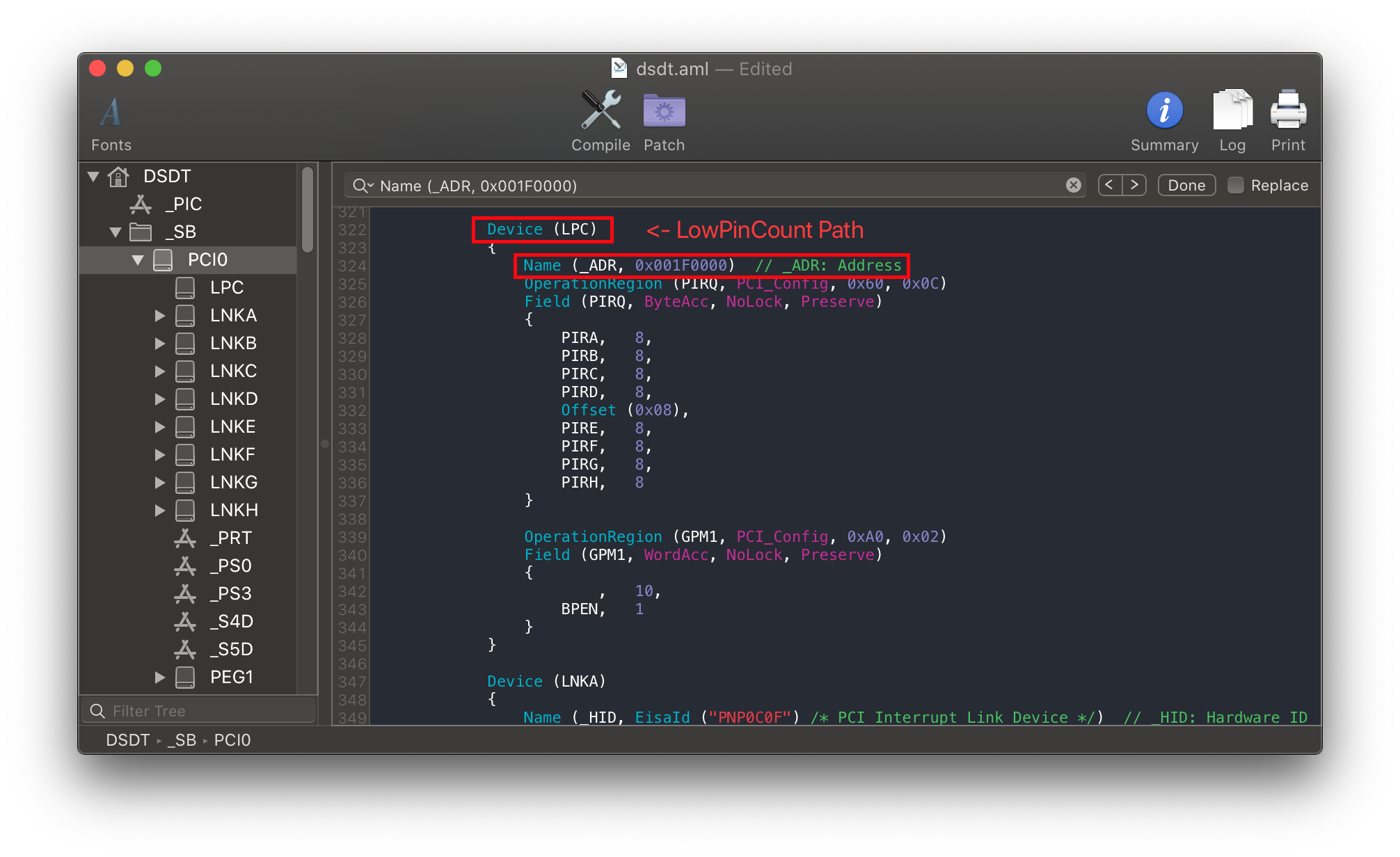 | 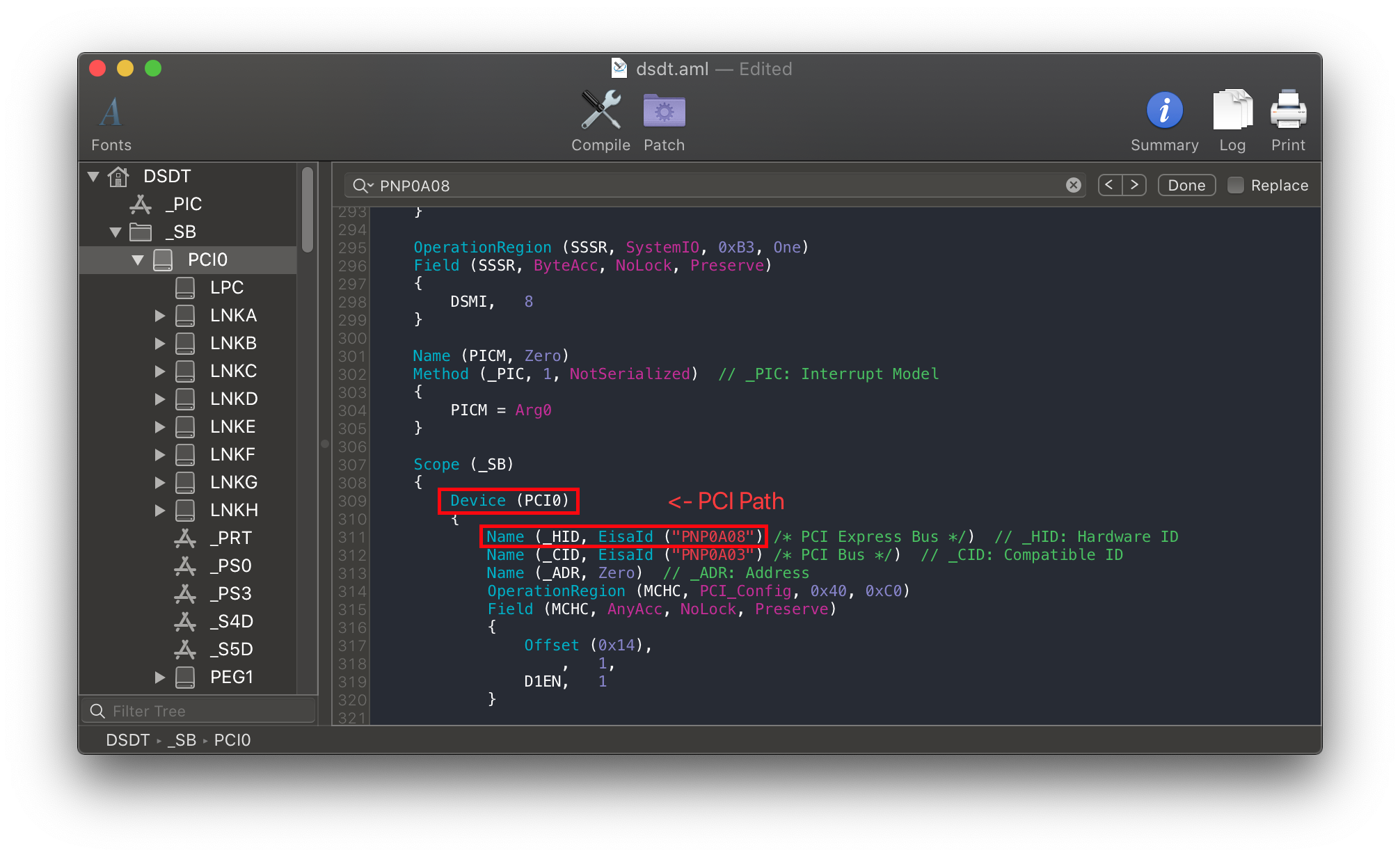 |
From the above, we can see we have both PCI0 and LPC. Now we can head to the next stage
Edits to the sample SSDT
Now that we have our ACPI path, lets grab our SSDT and get to work:
By default, this uses PCI0.LPCB for the pathing. you'll want to rename accordingly.
Following the example from above, we'll be renaming it to PCI0.LPC:
External (_SB_.PCI0.LPCB, DeviceObj) <- Rename this
Scope (_SB.PCI0.LPCB) <- Rename this
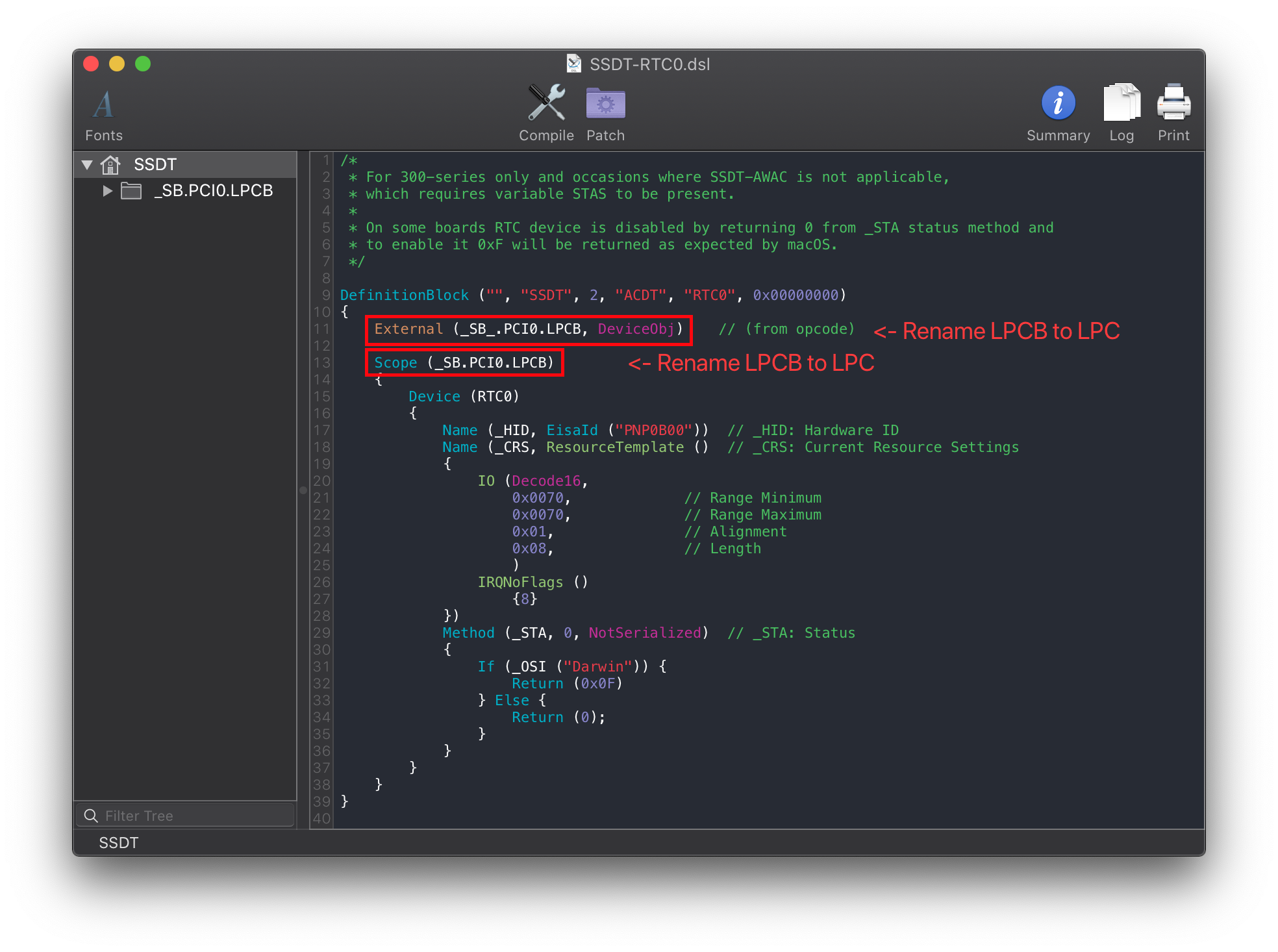
Following the example pathing we found, the SSDT should look something like this:
External (_SB_.PCI0.LPC, DeviceObj) <- Renamed
Scope (_SB.PCI0.LPC) <- Renamed
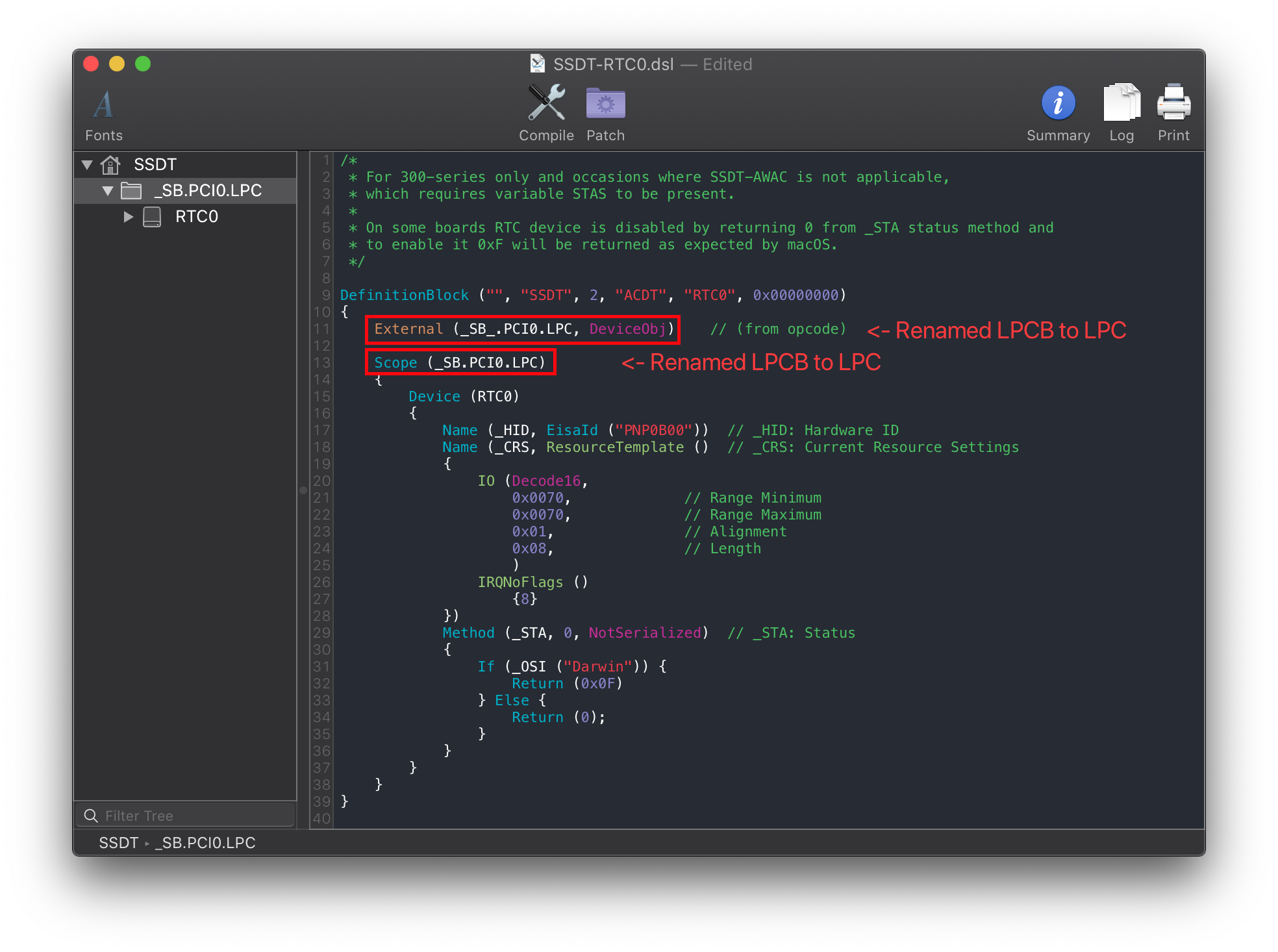
Compiling the SSDT
With the SSDT done, you're now ready to compile the SSDT!
Manual HEDT
Seeing if you need SSDT-RTC0-RANGE
To start, first open your decompiled DSDT you got from Dumping the DSDT and Decompiling and Compiling with either MaciASL(if in macOS) or any other text editor if in Windows or Linux(VSCode has an ACPI extension that can also help).
Now search for PNP0B00 and look at the _CRS entry within it:
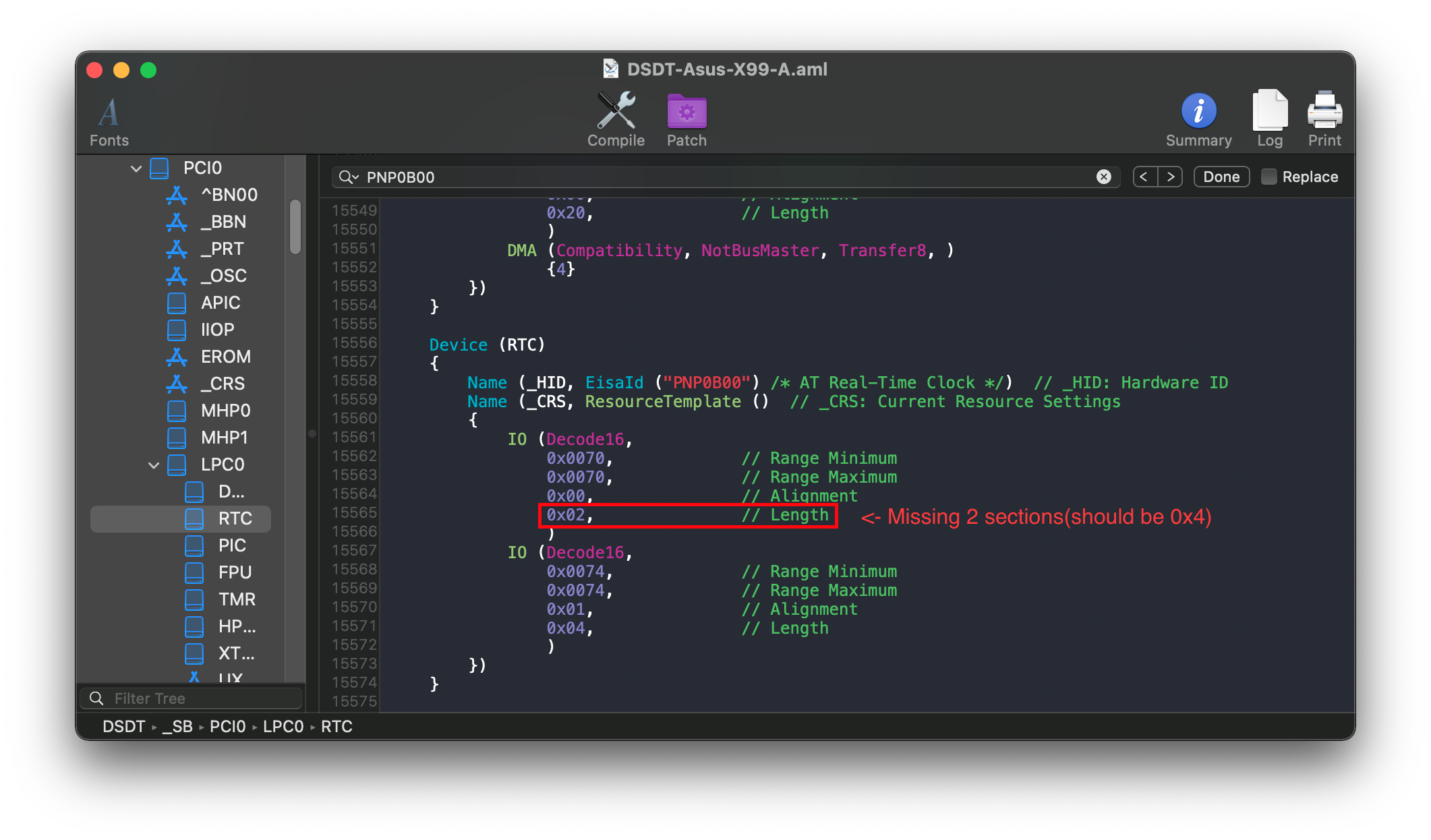
And from the above example, we see we have 2 banks of RTC memory:
- Bank 1: starts at 0x70 and is length 0x2
- Bank 2: starts at 0x74 and is length 0x4
Now the problem is that the OEM forgot to mat sections 0x72 and 0x73. Because of this, macOS may halt while booting(prominently in Big Sur)
And finally, verify if it has an _STA method as well. This will be used shortly
Finding the ACPI path
Finding the ACPI pathing is quite easy actually, first open your decompiled DSDT you got from Dumping the DSDT and Decompiling and Compiling with either MaciASL(if in macOS) or any other text editor if in Windows or Linux(VSCode has an ACPI extension that can also help).
To start, search for the following:
- Finding the RTC name:
- Search
PNP0B00
- Search
- Finding the LowPinCount path:
- Search
Name (_ADR, 0x001F0000)
- Search
- Finding the PCI path:
- Search
PNP0A08(If multiple show up, use the first one)
- Search
You should get something like the following show up:
| RTC Pathing | LPC Pathing | PCI Pathing |
|---|---|---|
 |  |  |
From the above, we can see we have RTC, LPC0 and PCI0. Now we can head to the next stage
Edits to the sample SSDT
Now that we have our ACPI path, lets grab our SSDT and get to work:
By default, this uses PC00.LPC0.RTC for the pathing. you'll want to rename accordingly.
Following the example from above, we'll be renaming it to PCI0.LPC0.RTC:
External (_SB_.PC00.LPC0, DeviceObj) <- Rename this
External (_SB_.PC00.LPC0.RTC_, DeviceObj) <- Rename this
Scope (_SB.PC00.LPC0) <- Rename this
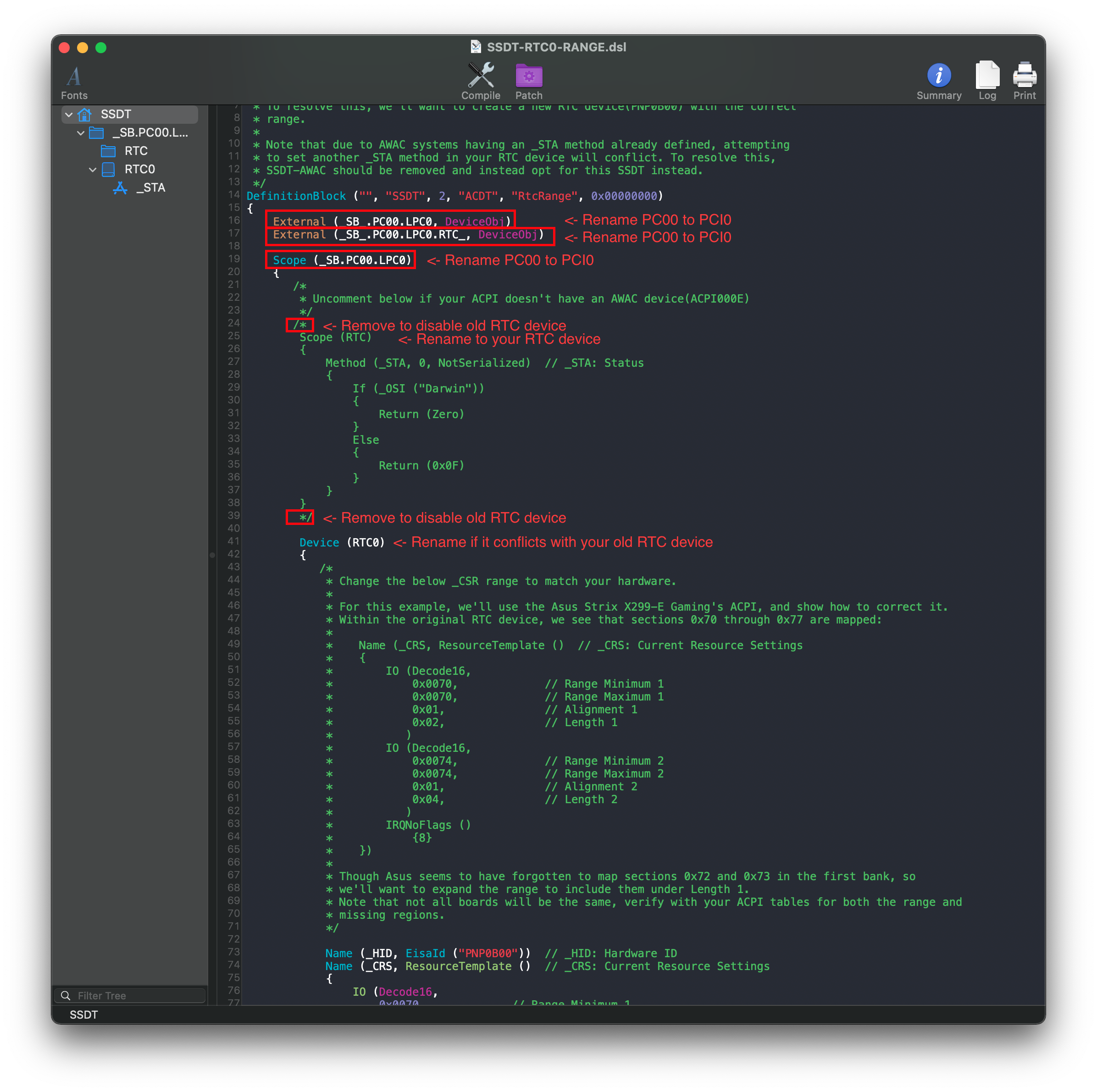
Following the example pathing we found, the SSDT should look something like this:
External (_SB_.PCI0.LPC0, DeviceObj) <- Renamed
Scope (_SB.PCI0.LPC0.RTC) <- Renamed
Scope (_SB.PCI0.LPC0) <- Renamed
/* <- Remove if your RTC device didn't have an _STA
Scope (RTC)
{
Method (_STA, 0, NotSerialized) // _STA: Status
{
If (_OSI ("Darwin"))
{
Return (Zero)
}
Else
{
Return (0x0F)
}
}
}
*/ <- Remove if your RTC device didn't have an _STA
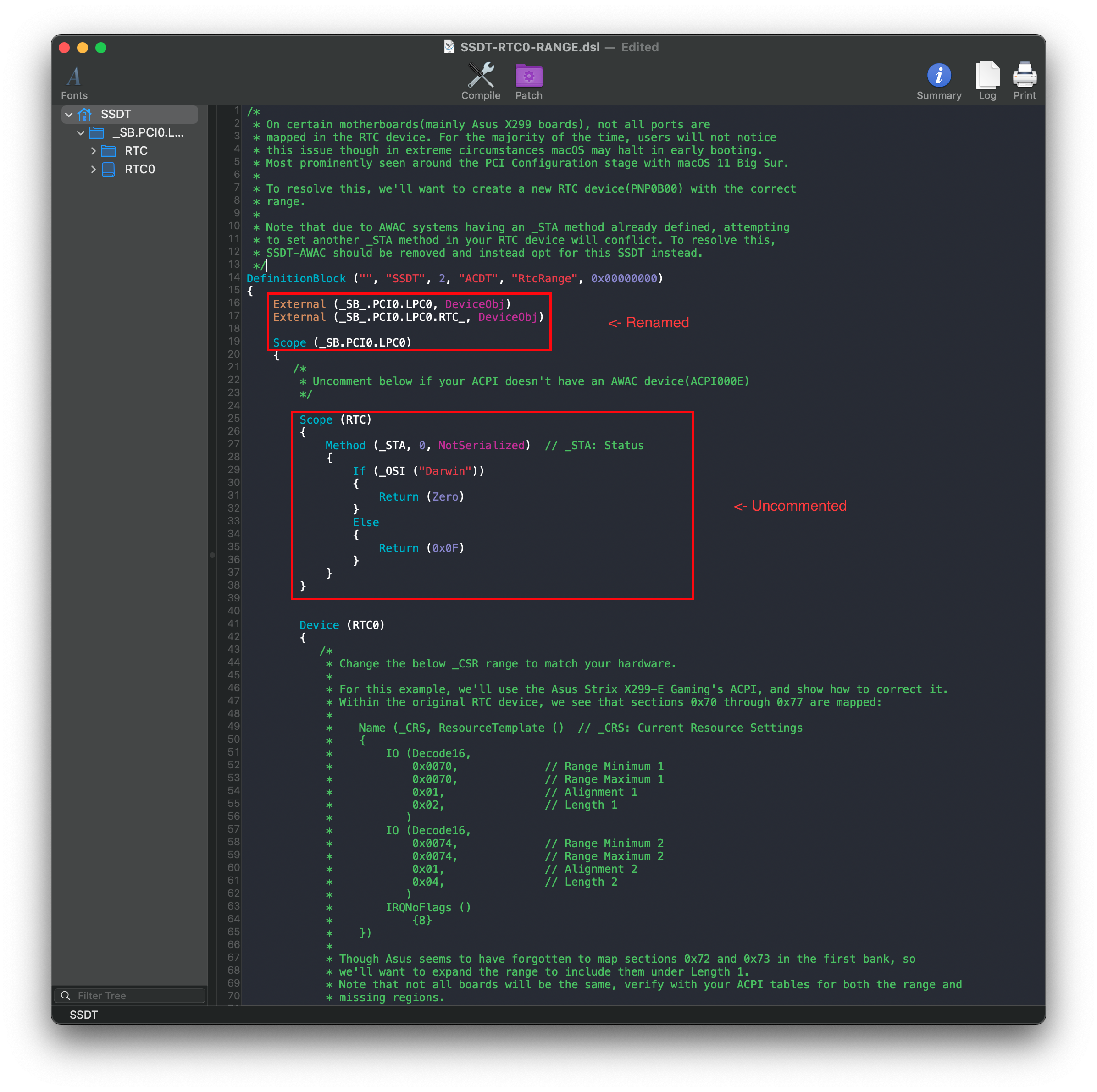
Compiling the SSDT
With the SSDT done, you're now ready to compile the SSDT!
Wrapping up
Once you're done making your SSDT, either head to the next page to finish the rest of the SSDTs or head here if you're ready to wrap up:
